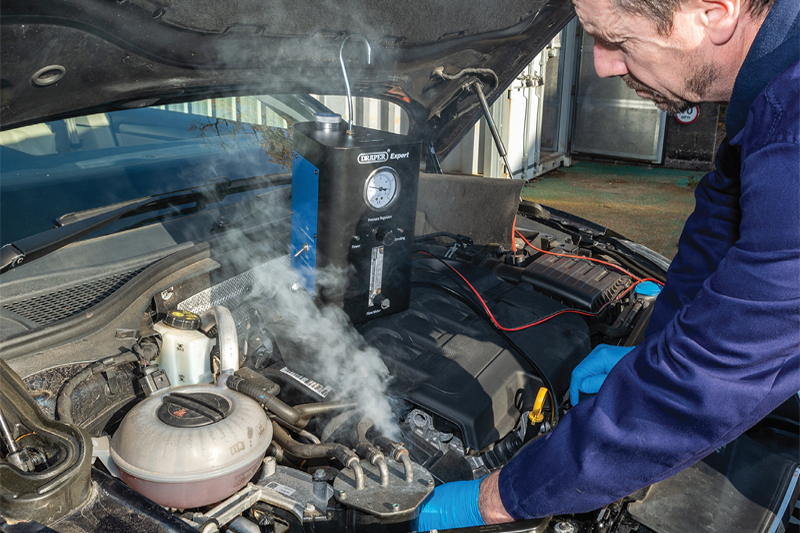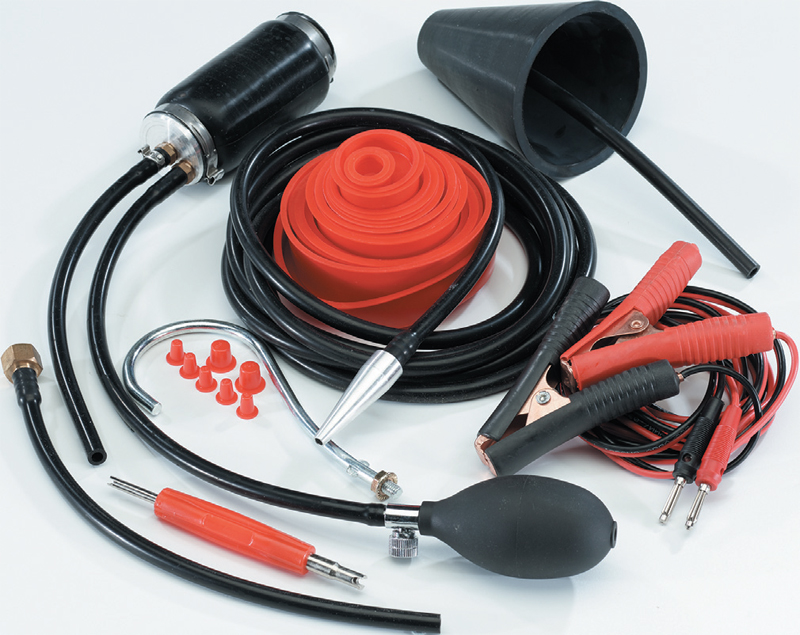
Draper Tools explains how its smoke diagnostic machine has the potential to significantly reduce the time it takes to diagnose specific vehicle system leaks.
Using smoke is one of the fastest ways to detect leaks in vehicle systems. In many cases, this method can save technicians hours of diagnostic work. This guide will explore a few examples, using the Draper Expert Turbo/EVAP Smoke Diagnostic Machine (stock number: 94079).
What can you use smoke diagnostics for?
One of the primary uses for a smoke diagnostic machine is to find splits and leaks on plastic or rubber intake pipes that can cause an erratic fuel/air mix going into the engine. You can also use a smoke machine such as the Draper Expert model on turbo pipes on the exhaust side of the engine, and with EVAP pipes on the fuel systems (a special low pressure setting is required for this).
Another important application of smoke diagnostics is to find water leaks. If a faulty door or window seal is causing a leak into a vehicle, a technician can use smoke to locate the problem – a method that significantly reduces the length of time it takes to reach a diagnosis.
Smoke diagnostic machines can also assist you in locating leaks in vacuum lines as well as manifolds, EGR valves, oil seals, gaskets, solenoids, ducting, throttle shafts, diaphragms, canisters and more.
How to use the air intake adaptor
To start, ensure that your smoke diagnostics kit has an air intake adaptor (there is one included with the Draper Expert model). The adaptor kits feature a block-off bladder, which you simply inflate, in order to seal the induction system. Draper Tools claims that the air intake adaptor will fit any vehicle intake.
It’s important to ensure that the bladder is fully inside the tubing before you inflate it, and it’s equally important to check that there are no obstructions or sharp edges that might puncture the bladder when inflated. Use the hand pump to inflate the bladder until the intake is tightly sealed. With the system sealed by the inflated bladder, it is then a case of adding smoke by plugging the smoke nozzle into the tube opening. Your smoke diagnostic machine should quickly produce smoke and once this enters the intake system, any leaks will soon become obvious and easy to pinpoint for repair. The simple process can quickly highlight even the smallest of leaks before they go on to become a bigger problem – potentially allowing garages to increase revenue with an additional repair job.
Make sure the system being tested is fully depressurised before you slowly release the internal pressure of the air intake adaptor. Complete the process by cleaning the adaptor so it’s ready for storage, making sure to avoid contact with corrosive liquids when doing so.

How to carry out EVAP low pressure & turbo high pressure testing
When it comes to EVAP testing and identifying leaks in this system, you need a method that only puts out very low pressure. Putting anything more than around 1psi of pressure into an EVAP system could damage it. With the Draper Expert 94079 model, the low-pressure mode system delivers only 0.75psi, making it ideal for the job.
Most EVAP systems are open or vented, so you will need to prepare the system by closing possible openings – such as the purge solenoid, the vent solenoid, the fuel cap, and filler neck – before you use your smoke machine to test it. It is also important to refer to the vehicle manufacturer in order to identify the correct test procedures and pressures for the model you are working on.
With all the prep done, you can turn the flow control knob on the Draper Expert model anti-clockwise to release air pressure – the flow meter will indicate the flow and measure the leak size.
With a smoke machine, you can also carry out high pressure diagnostic leak detection for turbo, diesel and boosted systems. In fact, with the 94079 model you can switch between the turbo and EVAP testing functions with ease.
To set up for turbo system testing, you need to set the desired test pressure by adjusting the pressure regulator and lock it in place, then ensure that your hose is attached correctly and turn the flow valve to release the smoke.
Smoke safety tips
- Always read and familiarise yourself with your smoke diagnostic machine’s instruction manual
- Always wear proper safety protection
- Refer to the vehicle manufacturer for the correct test procedures and pressures
- Remember that all smoke diagnostic work should be performed with the engine off
- Ensure that the vehicle is secure and stable and that you do not leave it unattended while smoke diagnostic equipment is connected or operating
- You should never perform tests near a source of spark of ignition
- When working with a vehicle’s fuel system, be sure to work in a well-ventilated area









